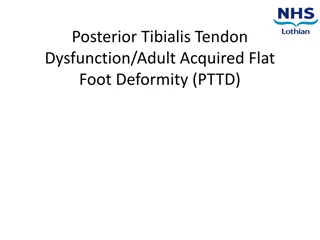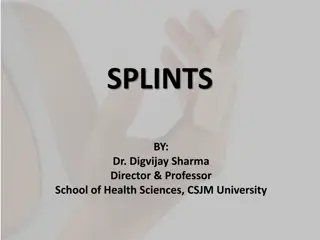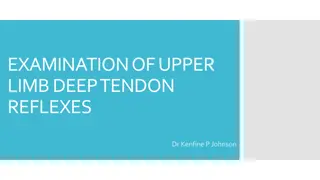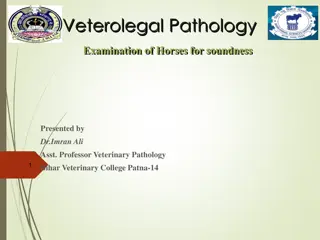A New Paradigm for Spasticity Management
New approach to managing spasticity, a disorder characterized by increased muscle tone and exaggerated tendon jerks. The author, Dr. Darryl Kaelin, explores the benefits of this new paradigm and its potential impact on motor control. The article also includes information on the etiologies and preval
1 views • 39 slides
Comprehensive Guide on Injury, Poisoning, and External Causes
This detailed guide covers various aspects of injuries, poisonings, and other consequences from external causes. It includes information on ICD10 and ICD9 coding, recording and treatment details, vocabulary related to different types of injuries, body parts classification, and code structures for di
2 views • 39 slides
Best Knee Replacement Surgeons in India
Knee is the largest joint of the human body, it is a hinge joint which allows flexion and extension and also slight internal and external rotation. It connects our thigh to our lower leg. Similar to all other joints, the knees are part of our skeletal system. The knee helps to support our weight. It
0 views • 2 slides
Distal Radius Fracture Surgery Patient Information
A distal radius fracture, commonly known as a wrist fracture, is a break in the radius bone near the wrist joint. Surgery may be necessary to realign and stabilize the bone to prevent complications such as stiffness, weakness, and pain. After surgery, patients should watch out for signs of infection
0 views • 4 slides
Understanding Proprioceptors and Their Role in Body Balance
Proprioceptors play a crucial role in providing information about the position of body parts, muscle spindle response to stretch, and muscle tension regulation. Muscle spindles and Golgi tendon organs are key components in maintaining muscle tone and ensuring proper reflex actions. This article delv
1 views • 23 slides
Understanding Achilles Tendinopathy: Causes, Symptoms, and Management
Achilles tendinopathy refers to pain, swelling, and physical impairment of the Achilles tendon. The causes include excessive loading, tight calf muscles, increased body weight, and biomechanical factors. Symptoms range from pain along the tendon to restricted ankle movement. Diagnosis involves a hea
0 views • 12 slides
Understanding Posterior Tibialis Tendon Dysfunction (PTTD) in Adults
Posterior Tibialis Tendon Dysfunction, also known as Adult Acquired Flat Foot Deformity (PTTD), is a condition that affects the tibialis posterior tendon, leading to reduced arch support. Common causes include obesity, trauma, age, and existing health conditions. Symptoms may include ankle pain, swe
0 views • 12 slides
Understanding Frozen Shoulder and Adhesive Capsulitis
Periarthritis of the shoulder, also known as adhesive capsulitis or frozen shoulder, is a condition characterized by pain, stiffness, and limited range of motion in the shoulder joint. Risk factors include immobilization, tendon inflammation, stroke, lung disease, diabetes, and more. Clinical featur
0 views • 24 slides
Understanding Splints: Types, Functions, and Applications in Rehabilitation
Splints are essential devices used for stabilizing and supporting injured body parts, primarily in the upper extremities. They help maintain structural integrity, prevent unwanted movements, reduce pain, and promote rehabilitation through various types, including static and dynamic splints. Aeroplan
1 views • 19 slides
Understanding Upper Limb Deep Tendon Reflexes Examination
Exploring the intricacies of upper limb deep tendon reflexes (DTR) examination, this comprehensive guide elaborates on the monosynaptic stretch reflex mechanism, protective role of stretch reflexes, grading of reflexes, factors influencing reflex activity, and reinforcement techniques like the Jendr
0 views • 28 slides
Understanding the Biological Basis of Human Motion and Motor Learning
In the biological basis of human motion, a series of electro-chemical-physical reactions occur at the neuromuscular junction, enabling nerve stimulation for muscle contraction. Nerve impulses for movement originate in the central nervous system or muscles, with acetylcholine transmitting impulses be
0 views • 13 slides
Understanding Training, Straining, and Tendon Science with Jonathan Hodges, DPT
Develop a fundamental understanding of acute:chronic loading, the science behind tendon strains vs. tendinopathies, and best programming to reduce injury risk. Explore the impact of training variables, strains, tendinopathies, training volume, acute on chronic training loads, and establishing load p
0 views • 31 slides
Understanding Flexibility and Stretching Techniques
Flexibility is crucial for optimal physical performance and injury prevention. It refers to the ability to move joints through a full range of motion without restrictions. Factors limiting flexibility include tissue elasticity, bony structure, and muscle/tendon extensibility. Understanding active an
0 views • 28 slides
Dealing with Jerks in the Legal Profession
This content discusses the challenges lawyers face when dealing with difficult individuals in the legal field, known as "jerks." It provides examples of jerk behavior, tips on differentiating them from advocates, and strategies for handling such situations professionally. The discussion delves into
0 views • 34 slides
Understanding Wire Ropes for Flexible Load Handling Attachment
Wire ropes offer advantages over chains for flexible load handling attachment, such as lighter weight, less damage susceptibility from jerks, silent operation, and greater reliability. They consist of multiple wires or strands wound about an axis, with independent components interacting during servi
0 views • 17 slides
Pediatric Ankle and Knee Pain Imaging Findings
Images show calcifications in Achilles tendon and deep to plantar fascia in a 7-year-old with ankle pain, as well as a cortical abnormality in the distal femur of a 16-year-old girl presenting with knee pain. The significance of these findings requires further evaluation by a medical professional.
0 views • 6 slides
Veterolegal Pathology: Examination of Horses for Soundness by Dr. Imran Ali, Asst. Professor at Bihar Veterinary College
In the field of veterolegal pathology, examining horses for soundness is crucial for assessing their natural usefulness. This examination involves identifying conditions such as bone spavin, bog spavin, bowed tendon, and curb, each with specific symptoms that indicate unsoundness as per legal defini
0 views • 18 slides
Understanding Biomechanics of Musculoskeletal Tissues and Mechanics Terms
Explore the function of musculoskeletal tissues (bone, cartilage, tendon), biomechanics' role in understanding tissue structure and joint function, mechanics terms like stress, strain, force, and more. Discover how force and stress impact deformable bodies and the relationship between force and defo
2 views • 23 slides
Coolmax Polyester Socks Achilles Tendon Care in Netherlands
Stay comfortable and dry all day with Coolmax Polyester socks. Designed for active lifestyles, these socks feature advanced moisture-wicking technology that keeps your feet cool and sweat-free. Perfect for running, walking, or everyday use, Coolmax P
2 views • 8 slides
Understanding Finger Injuries and Proper Assessment Guidelines
Hand injuries, especially finger injuries, are common in emergency departments. Proper diagnosis and management are crucial to prevent long-term complications. This content covers information on tendon anatomy, nerve innervation, and assessment guidelines for finger injuries.
0 views • 67 slides



















